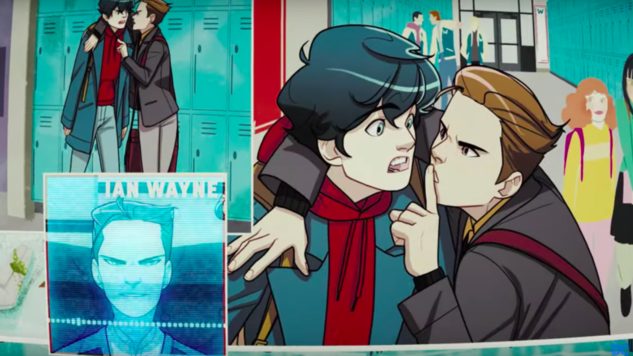Trailer Reveal & Interview: Ridley Pearson Launches Super Sons: The Polarshield Project at DC Zoom
Main Art by Ile Gonzalez
One of the comic industry’s most-anticipated moments of 2019 is finally upon us: the launch of DC Comics’ DC Zoom imprint for middle-grade readers (ages eight to 12) and DC Ink imprint for YA audiences (ages 13 and up). Designed to reach a readership frequently ignored by mainstream superhero comics, DC Zoom and DC Ink have recruited major prose talent from the middle-grade and YA worlds to write these new adventures, including Danielle Paige, Lauren Myracle, Laurie Halse Anderson, Shannon and Dean Hale, Meg Cabot and Ridley Pearson.
Pearson, perhaps best known for the Kingdom Keepers series, is first up to bat for DC Zoom with Super Sons: The Polarshield Project. Illustrated by newcomer Ile Gonzalez, The Polarshield Project kicks off a trilogy that re-imagines the titular Super Sons—Jon Kent and Damian “Ian” Wayne—from the ground up, maintaining their familial bonds to Superman and Batman but otherwise largely revamping their heroic journeys.
With The Polarshield Project available for preorder now and hitting shelves everywhere April 2nd, 2019, Paste exchanged a few questions with Pearson to find out more about his take on Jon and Ian, the inspiration behind new character Candace, how he approached the book’s climate crisis and what it was like crossing over from prose to comics. We’ve also got the exclusive debut of DC Zoom’s trailer for the graphic novel, featuring Gonzalez’ vibrant, colorful artwork.
![]()
Paste: This Jon and Damian aren’t the same Jon and Damian mainstream DC readers are used to following—Damian doesn’t even like to be called by his full name. How much freedom did DC offer you in reimagining the characters for Super Sons, and what went into decisions like having “Ian” not be Robin in this universe?
Ridley Pearson: DC gave me free reign to create a new Super Sons world. I was to start from scratch and find a way to work multiple plot lines in a middle grade readership unbound by previous Super Sons history. For me, the name “Damian” had pejorative overtones from a slate of horror films. I abbreviated to “Ian” to give him a fresh start and to allow me to focus on bringing the two boys together over time as teammates.
Being the first in a series, before starting The Polarshield Project, I wrote character bios and location descriptions and worked with my DC editors to world-build. Hopefully young readers find themselves in an extraordinary world that has resonance and meaning.
Paste: Similarly, Gotham and Metropolis still exist in the world of Super Sons, but the action quickly moves to a brand-new city, and the backmatter actually clarifies that this universe has different countries and continents than the universe in which we live. Out of curiosity, what inspired this change of settings from the familiar DC locales?
Pearson: I want to pay homage to the incredible DC Universe without wandering into places I don’t belong. Since writing comics is new to me, I wanted to create new locations out of respect. DC encouraged me to world-build in order to give the Super Sons a new playground. Place can become character in fiction. I had ideas about how to shape that place—or places—to introduce environmental issues and give both the characters and readers a palpable danger.
Paste: The first volume’s subtitle, The Polarshield Project, refers to a sci-fi version of a real proposal for coping with climate change—“seeding” the air with particles that will reflect sunlight and allow temperatures to stabilize. Can you speak a bit about your decision to make climate change a key part of this series, and how you set about explaining this concept to younger readers?
-

-

-

-

-

-

-

-

-

-

-

-

-

-

-

-

-

-

-

-

-

-

-

-

-

-

-

-

-

-

-

-

-

-

-

-

-

-

-

-









































